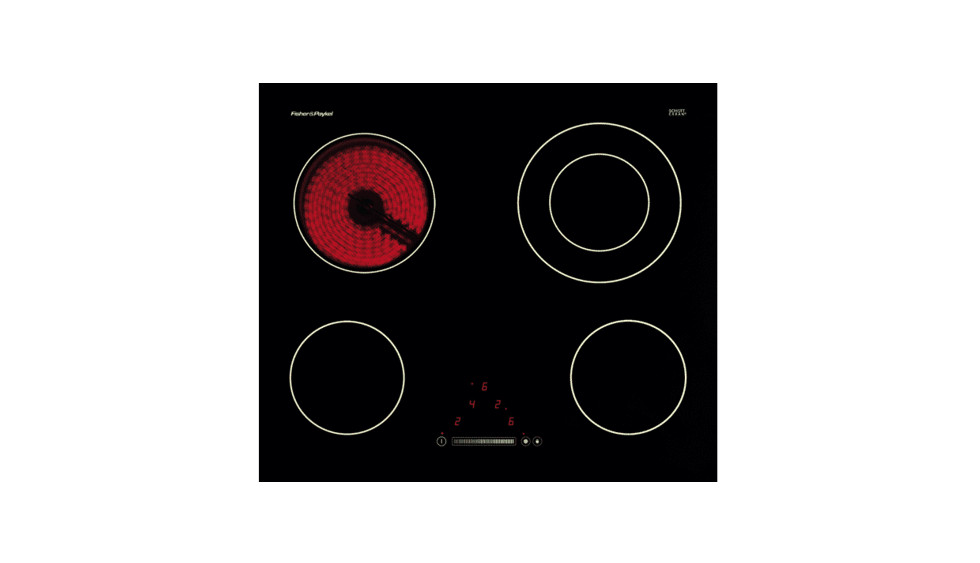
CERAMIC GLASS COOKTOPCE302C, CE604L, CE604C & CE905Cmodels
INSTALLATION INSTRUCTIONSUSER GUIDENZ AU HK SG
IMPORTANT!SAVE THESE INSTRUCTIONSThe models shown in this user guide may not be available in all markets and are subject to change at any time. For current details about model and specification availability in your country, please go to our website www.fisherpaykel.com or contact your local Fisher & Paykel dealer.
SAFETY AND WARNINGS
Your safety is important to us. Please read this information before using your cooktop.
Installation
 WARNING!
WARNING!







IMPORTANT SAFETY INSTRUCTIONS
Installation● Read these instructions carefully before installing or using this appliance.● No combustible material or products should be placed on this appliance at any time.● Please make this information available to the person responsible for installing the appliance as it could reduce your installation costs.● In order to avoid a hazard, this appliance must be installed according to these instructions for installation.● This appliance is to be properly installed and earthed only by a suitably qualified person.● This appliance should be connected to a circuit that incorporates an isolating switch providing full disconnection from the power supply.● Failure to install the appliance correctly could invalidate any warranty or liability claims.
Operation and maintenance




![]()
![]()
![]()
![]()


![]()
![]()
![]()
![]()


![]()
![]()
![]()
![]()


IMPORTANT SAFETY INSTRUCTIONS● CAUTION: The cooking process has to be supervised. A short-term cooking process has to be supervised continuously.● Never leave the appliance unattended when in use. Boilover causes smoking and greasy spillovers that may ignite.● Never use your appliance as a work or storage surface.● Never leave any objects or utensils other than suitable cookware on the appliance.● Never use your appliance for warming or heating the room.● Do not allow children to play with the appliance or sit, stand or climb on it.● Do not store items of interest to children in cabinets above the appliance. Children climbing on the cooktop could be seriously injured.● Do not leave children alone or unattended in the area where the appliance is in use.● Children less than 8 years old must be kept away from the appliance unless continuously supervised.● This appliance can be used by children aged from 8 years and above, and persons with reduced physical, sensory or mental capabilities or lack of experience and knowledge, if they have been given supervision or instruction concerning the use of the appliance in a safe way and they understand the hazards involved.● Cleaning and user maintenance shall not be done by children without supervision.● Do not repair or replace any part of the appliance unless specifically recommended in the manual. All other servicing should be done by a qualified technician.● Do not use a steam cleaner to clean your cooktop.● Do not place or drop heavy objects on your cooktop.● Do not stand on your cooktop.● Do not use pans with jagged edges or drag pans across the ceramic glass surface as this can scratch the glass.● Do not use scourers or any other harsh/abrasive cleaning agents to clean your cooktop, as these can scratch the ceramic glass.● If the power supply cable is damaged, it must only be replaced by a qualified technician.● Do not operate your cooktop by means of an external timer or separate remote-control system.
INSTALLATION INSTRUCTIONS
Cooktop and cutout dimensionsDrawings for illustration purposes only

Terminal block location:1. CE604L, CE604C & CE905C models – Middle rear2. CE302C models – Front left
| PRODUCT AND CUTOUT DIMENSIONS | CE302C | CE604L | CE604C | CE905C |
| MM | MM | MM | MM | |
| PRODUCT AND CUTOUT DIMENSIONS | 299 | 599 | 599 | 899 |
| A. Overall width of cooktop | 530 | 530 | 530 | 530 |
| B. Overall depth of cooktop | 46 | 46 | 46 | 46 |
| C. Height of terminal block (below top of bench) | 63 | 53 | 53 | 53 |
| D. Width of chassis | 269 | 557 | 557 | 865 |
| E. Depth of chassis | 487 | 487 | 487 | 489 |
| F. Overall width of the cutout | 270 | 560 | 560 | 870 |
| G. Overall depth of the cutout | 490 | 490 | 490 | 490 |
ClearancesDrawings for illustration purposes only

| CLEARANCE DIMENSIONS | CE302C | CE604L | CE604C | CE905C |
| MM | MM | MM | MM | |
| A. Minimum clearance from the rear edge of cutout to:nearest combustible surface | 55 | 55 | 55 | 55 |
| B. Minimum clearance from the glass surface to:rangehood | 650 | 650 | 650 | 650 |
| C. Minimum clearance from side edges of the cutout to:nearest combustible surface | 65 | 70 | 70 | 65 |
| D. Minimum clearance from benchtop to:overhead cabinet not directly above the cooktop | 450 | 450 | 450 | 450 |
| E. Minimum clearance below the top of benchtop to:thermal protection barrier | 65 | 65 | 65 | 65 |
Before you install the cooktop, make sure that
● the benchtop is square and level, and no structural members interfere with space requirements● the benchtop is made of a heat-resistant material● the cooktop will not be installed directly above a dishwasher, as the humidity may damage the cooktop● the installation will comply with all clearance requirements and applicable standards and regular tions● a suitable isolating switch providing full disconnection from the mains power supply is incorporated in the permanent wiring, mounted and positioned to comply with the local wiring rules and regulations. The isolating switch must be of an approved type and provide a 3 mm air gap contact separation in all poles (or in all active [phase] conductors if the local wiring rules allow for this variation of the requirements)● the isolating switch will be easily accessible to the customer with the cooktop installed● you consult local building authorities and by-laws if in doubt regarding installation● you use heat-resistant and easy-to-clean finishes (such as ceramic tiles) for the wall surfaces surrounding the cooktop.
When you have installed the cooktop, make sure that
● the power supply cable is not accessible through cupboard doors or drawers● there is an adequate flow of fresh air from outside the cabinetry to the base of the cooktop● if the cooktop base is accessible through a cupboard or drawer space after installation, a thermal protection barrier is installed below the base of the cooktop (see below)● the isolating switch is easily accessible by the customer● you complete the ‘Final checklist’ at the end of these installation instructions.
The thermal protection barrier must be:
● removable● heat-resistant● made from low thermal conductivity material● at least 20 mm below the base of the cooktop to ensure adequate ventilation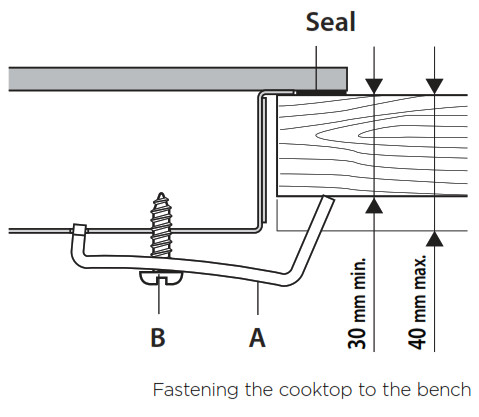

Fastening the cooktop to the bench
1. Turn the cooktop upside down and place it on a soft surface.2. Spread the seal around the edges of the ceramic glass with the adhesive side facing down, making sure that the whole perimeter is sealed. Cut off any excess material. 3 Mount the supplied clamps (A) and screws (B) onto the cooktop, as shown (without tightening the screws).4. Place the cooktop into the cutout, then tighten the screws to clamp the cooktop securely to the bench.5. Using a sharp cutter or trimmer knife, trim the excess sealing material around the edge of the cooktop. Take care not to damage the benchtop.Note: if your bench is thicker than 40 mm, recess the underside to between 30 and 40 mm.
CE905C models only: Choose the most suitable clamp position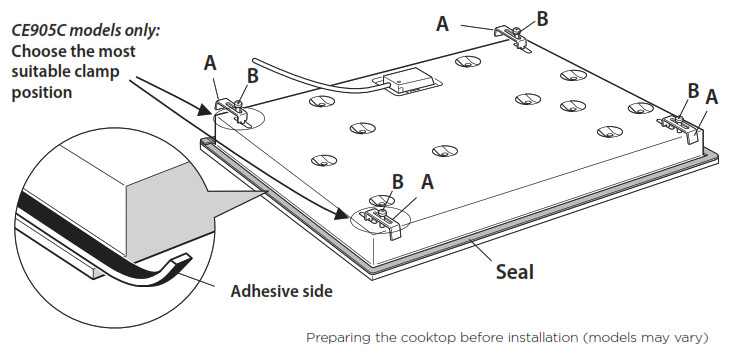

Preparing the cooktop before installation (models may vary)
Seal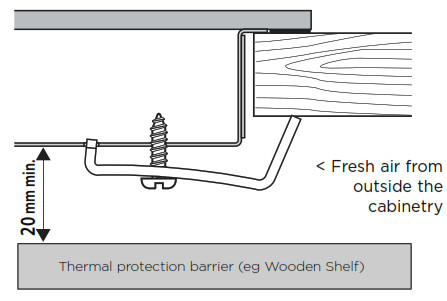

Fastening the cooktop to the bench
Connecting the cooktop to the mains power supply
IMPORTANT!● This cooktop must be connected to the mains power supply only by a suitably qualified person.● This cooktop must be earthed.● Before connecting the cooktop to the mains power supply, check that:● the domestic wiring system is suitable for the power drawn by the cooktop● the voltage corresponds to the value given on the rating plate● the power supply cable sections can withstand the load specified on the rating plate.● To connect the cooktop to the mains power supply, do not use adapters, reducers, or branching devices, as they can cause overheating and fire.● The power supply cable must not touch any hot parts and must be positioned so that its temperature will not exceed 75 o C at any point.Power supply CE302C 2900W @ 220-240V~ (12.6 A) CE604L 6000W @ 220-240/380-415V 3N~ (26 A) CE604C 6400W @ 220-240/380-415V 3N~ (27.8 A) CE905C 8400W @ 220-240/380-415V 3N~ (36.5 A) IMPORTANT! Check with an electrician whether the domestic wiring system is suitable without alterations.Any alterations must only be made by a qualified electrician.Connection diagrams
CE302C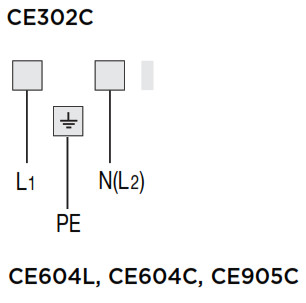



TO BE COMPLETED BY THE INSTALLER
- Is the cooktop earthed?
- Check that the power supply cable is NOT touching the base of the cooktop. This will ensure that the cable is not damaged by heat from the cooktop.
- Check that the power supply cable is not accessible via cupboard doors or drawers.
- Is the cooktop clamped down securely?
- Check that all the cooking zones function correctly. Turn on all of them to a high setting and leave them on for at least one minute.
- Are all elements glowing?
- Are all ‘Hot surface’ indicators glowing?
- Have you shown the customer how to use the cooktop? Make sure you explain to the customer about the ‘Hot surface’ indicators. Encourage them to read the full user guide before using the cooktop.
Complete and keep for safe reference:ModelSerial No.Purchase DatePurchaserDealer AddressInstaller’s NameInstaller’s SignatureInstallation CompanyInstallation Date
INTRODUCTION
About your new cooktopThank you for buying a Fisher & Paykel ceramic glass cooktop. This guide introduces you to all its special features. We recommend you read the whole guide before using your new cooktop, for both safety and cooking success.
For more information, visit our local website listed on the back cover.
- Before using your new cooktop Read this user guide, taking special note of the ‘Safety and warnings’ section.
- Remove any protective film that may still be on your cooktop.


1. Single cooking zone2. Dual cooking zone3. Cooking zone with SuperSimmer feature4. ‘Hot surface’ indicators5. Control dials
USING YOUR COOKTOP
To start cooking● Turn the control dial of the cooking zone you wish to use to the High setting, then adjust as necessary.● When using dual cooking zones, you may choose to use the inner zone only (![]()
![]()
![]()
![]()


● Some models have a cooking zone with a unique SuperSimmer feature. This special, low turndown range is excellent for the most delicate cooking tasks, like melting chocolate or simmering soups and stews.● For further advice on cooking and using the SuperSimmer feature, see ‘Cooking guidelines’ following.
‘Hot surface’ indicators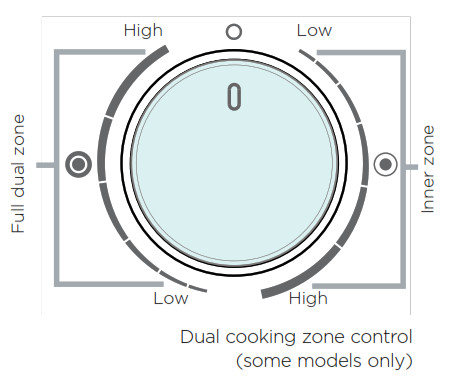

When you have finished cooking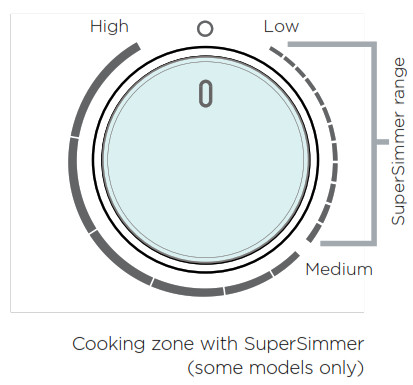

COOKING GUIDELINES
Cookware
● Use heavy-gauge, flat, smooth-based cookware that matches the diameter of the cooking zone. This will provide good contact with the glass and help reduce cooking times. Low heat or slow cooking is often due to incorrect cookware size.● Cookware with a stainless steel sandwich base or enameled cast iron will give you the best results.● Saucepans or heavy frying pans with jagged edges or a rough base will scratch the glass.● Always lift pans off the cooktop – do not slide, or they may scratch the glass.● Never use plastic or aluminum foil dishes on the cooktop.● Aluminum and copper-based cookware will leave metallic stains on the cooktop. To prevent these building up, clean the cooktop after every use following the instructions in ‘Care and cleaning’. If the metallic stains are allowed to burn onto the surface, they may react with the glass and may no longer be removable. They don’t, however, affect performance.● It is safe to place hot cookware from the oven, or another cooking zone, on the glass surface when the surface is cool.● Avoid placing anything in a hot cooking zone until it has cooled completely.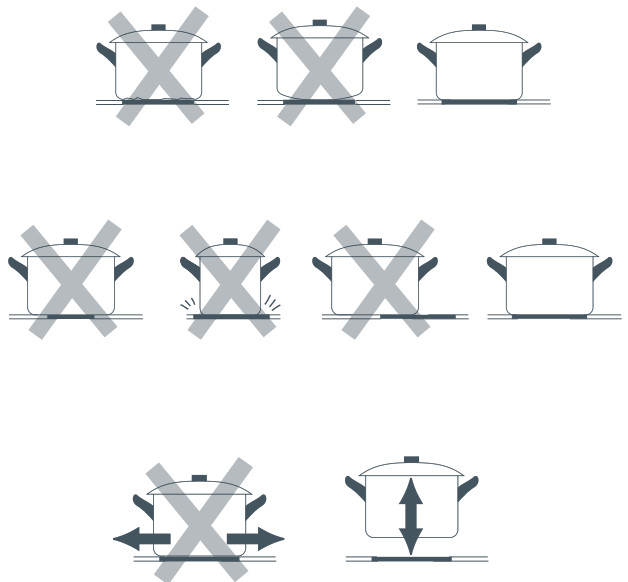

IMPORTANT! ● Never leave the appliance unattended when in use. Boilover causes smoking and greasy spillovers that may ignite.● Take care when deep-frying: oil or fat can overheat very quickly, particularly on a high setting.
General cooking tips● Using a lid will reduce cooking times by retaining the heat.● Minimize the amount of liquid or fat to reduce cooking times.● Start cooking on a high setting and reduce it when the food has come to a boil or heated through.● Even after a cooking zone has been turned off, its glass surface retains enough heat to continue cooking. To avoid overcooking, remove pans from hot cooking zones when the food is cooked.
Cooking rice, simmering● Some tasks, including cooking rice by the absorption method, may require a setting higher than the lowest setting to ensure the food is cooked properly in the time recommended.● Simmering occurs below boiling point when bubbles are just rising occasionally to the surface of the cooking liquid. It’s the key to delicious soups and tender stews because the flavors develop without overcooking the food. Egg-based sauces are best kept below boiling point throughout cooking, and flour-based sauces should also be gently simmered after they have reached boiling point. Using the
SuperSimmer feature (some models only)● The front right cooking zone on some models has a unique SuperSimmer feature. This allows the cooking zone to be turned down to very low and even heat settings. These are ideal for melting chocolate and butter, cooking rice and delicate sauces, simmering soups and stews, and keeping cooked food hot.● The high settings of the SuperSimmer cooking zone are just as powerful as those of the other cooking zones, allowing food to be browned, seared, sautéed, or boiled before simmering, all on the same cooking zones.
Searing steak
1. Stand the meat at room temperature for about 20 minutes before cooking.2. Heat up a heavy-based frying pan.3. Brush both sides of the steak with oil and season it to taste.4. Lower the meat onto the hot pan.5. Turn the steak only once during cooking. The exact cooking time will depend on the thickness of the steak and how cooked you want it.Times vary between 2 to 8 minutes per side. Press the steak to gauge how cooked it is: the firmer it feels, the more ‘well done it will be.6. Leave the steak to rest on a warm plate for a few minutes to allow it to relax and become tender before serving.
CARE AND CLEANING
IMPORTANT!● For your safety, switch the power to the cooktop off at the wall before any cleaning. In this case, there will be no ‘Hot surface’ indication, but the cooking zones may still be hot! Take extreme care.● Do not use a steam cleaner to clean your cooktop.● Do not use scourers or any harsh/abrasive cleaning agents to clean your cooktop, as these can scratch the ceramic glass or stainless steel.
| WHAT? | HOW? | IMPORTANT! |
| Light soiling on glass afterevery use– fingerprints and marks– stains left by non-sugaryliquids (eg water, soup, oil) | ● Wipe with a soft, damp cloth and mild detergent. A microfibre or ‘glass’ cloth is ideal for this.● Wipe dry with a clean cloth or paper towel. | Before cleaning, make sure that the glass is a safetemperature to touch. |
| Non-sugary boilovers, spills, and food stains on glass– burnt-on food or grease– pasta water, milk, soup | 1. Remove the soiling with ceramic cooktop cleaner using a sponge or non-abrasive scourer suitable for ceramic glass.2. Remove any excess cleaner and wipe dry with a clean cloth or paper towel.3. Apply ceramic cooktop conditioner or protector following the instructions on the dispenser.A microfibre or ‘glass’ cloth is ideal for this. | ● Heavy-duty scourers, some nylon scourers, and harsh/ abrasive cleaning agents may scratch the glass. Always read the label to check if your cleaner or scourer is suitable.● Never leave cleaner residue on the cooktop: the glass may become stained. |
| Hot sugary spills, melted plastic or metal on glass– sugar, sugary syrups– jams and jellies– vegetables or vegetable waterwith high sugar content (peas, sweetcorn, beetroot)– melted aluminum foil or plastic wrap | Remove these immediately with a spatula or razor blade scraper suitable for ceramic glass cooktops, but beware of hot spills and surfaces:1. Hold the blade or utensil at a 30o angle and scrape the soiling or spill to a cool area of the cooktop.2. Immediately clean the soiling up with a dishcloth or paper towel.3 . Follow the instructions for ‘Light soiling on glass after every use’ above. | ● Remove stains left by melts and sugary food or spillovers immediately. If left to cool on the glass, they may be difficult to remove or even permanently damage the glass surface.● Cut hazard: the blade in a scraper is razor-sharp when the safety cover is retracted. Use with extreme care and always store safely out of reach of children. |
| Metallic stains on glass caused by cookware with– copper base– aluminum base | ● Follow the instructions for ‘Non-sugary boilovers, spills and food stains on glass’ above● For stubborn metallic stains, try using a razor blade scraper suitable for ceramic glass cooktops, holding it at a 30o angle. | If the cooktop is not cleaned after every use and copper or aluminum stains are allowed to burn onto the surface, they may react with the glass and no longer be removable. They don’t, however, affect performance. |
| Stainless steel strip– food stains– fingerprints and marks | 1 Wipe the soiling off with a cloth using a mild household detergent or stainless steel cleaner.1 Wipe the surface dry using a microfibre cloth. 1 For extra shine, use a suitable stainless steel polish.. | ● Immediately wipe off any stainless steel cleaner if it is spilled onto the control dials.● Commercial stainless steel cleaners containing chlorine compounds are corrosive and may damage the appearance of your cooktop. Always read the label to check if your cleaner contains chlorine. |
| Control dials– food stains– fingerprints and marks | 1 Wipe with a damp cloth and mild detergent.1 Dry thoroughly with a soft cloth. | Do not use stainless steel cleaner on the dials, as doingso may damage their coating. |
TROUBLESHOOTING
| PROBLEM | POSSIBLE CAUSE | WHAT TO DO |
| Cooking zones cannot be turned on. | No power. | Make sure the cooktop is connected to the power supply and that it is switched on at the wall. Check whether there is a power outage in your home or area. If you’ve checked everything and the problem persists, call your Authorised Repairer or Customer Care. |
| Cooking zones seem to turn themselves off and on during use. | They cycle off and on to maintain the selected setting or prevent the glass from overheating. | This is normal and needs no action. |
| There is a metalsheen onthe glass. | Cookware with copper oraluminum base. | See ‘Care and cleaning’. |
| The glass is being scratched. | Rough-edged cookware. | Use cookware with flat and smooth bases. See ‘Cooking guidelines’. |
| Unsuitable, abrasive scourer being used. | See ‘Care and cleaning’. | |
| Cooking zones cannot be turned off. | Technical fault. | Switch the power to the cooktop off at the wall and call your Authorised Repairer or Customer Care. |
WARRANTY AND SERVICE
Before you call for service or assistance …Check the things you can do yourself. Refer to the installation instructions and your user guide and check that:1 . Your product is correctly installed.2 . You are familiar with its normal operation. If after checking these points you still need assistance or parts, please refer to the Service & Warranty book for warranty details and your nearest Authorised Service Centre, Customer Care, or contact us through our website www.fisherpaykel.com.
This cooktop has been designed and constructed in accordance with the following codes and specifications:
In New Zealand and Australia:● AS/NZS 60335-1:2011 General Requirements for Domestic electrical appliances● AS/NZS 60335-2-6:2014 Particular Requirements for Domestic electrical cooking appliances● AS/NZS CISPR 14.1.2013 Electromagnetic Compatibility Requirements. In Europe: Safety requirements of EEC Directive “Low voltage” 2014/35/EU:● EN 60335-1 General Requirements for Domestic electrical appliances● EN 60335-2-6 Particular Requirements for Domestic electrical cooking appliances Safety requirements of EEC Directive “EMC” 2014/30/EU::● EN 55014-1, EN 55014-2, EN 61000-3-2, EN 61000-3-3 Electromagnetic Compatibility Requirements
Requirements of EEC Directive 93/68/EEC and 2011/65/EU![]()
![]()
![]()
![]()
ENERGY GUIDELINES (GB IE ONLY)
Reducing the environmental impact
Reducing energy consumption will reduce the impact of cooking on the environment. You can reduce energy consumption by:
● Using the correct sized pot for the element.● Using a cover when bringing water to a boil.● Simmering foods instead of boiling vigorously.● Cutting food into smaller pieces to reduce the cooking time.● Using a steamer or a pan with a divider to cook different vegetables at the same time.● Thawing foods in the refrigerator first.● Using a pressure cooker.
| MODEL | NO.COOKINGZONES | DIAMETER/AREACOOKING ZONE | ENERGYCONSUMPTION*(PER ZONE) | ENERGYCONSUMPTION*(WHOLECOOKTOP) |
| CE302CBX | 2 | F 15cmR 18.5cm/12.5cm | F 187.0 Wh/kgR 200.9 Wh/kg | 194.0 Wh/kg |
| CE604LBX | 4 | LF 18.5cmLR 15.0cmRF 18.5cmRR 15.0cm | LF 194.7 Wh/kgLR 191.5 Wh/kgRF 194.7 Wh/kgRR 191.5 Wh/kg | 193.1 Wh/kg |
| CE604CBX | 4 | LF 21.2cm/13cmLR 15.0cmRF 18.5cmRR 15.0cm | LF 188.4 Wh/kgLR 191.5 Wh/kgRF 194.7 Wh/kgRR 191.5 Wh/kg | 191.5 Wh/kg |
| CE905CBX | 5 | LF 18.5cm/12.5cmLR 15.0cmCTR 23.5cm/14.5cmRF 18.5cmRL 15.0cm | LF 200.9 Wh/kgLR 191.5 Wh/kgCTR 190.5 Wh/kgRF 194.7 Wh/kgRL 191.2 Wh/kg | 193.8 Wh/kg |
* Energy consumption for electric cooking appliances are calculated using the following Standards1) BS EN 50304 & BS EN 60350 -Electric cooking ranges, hobs, ovens, and grills for household use- Methods for measuring performance.
FISHERPAYKEL.COM
© Fisher & Paykel Appliances 2018. All rights reserved.The product specifications in this booklet apply to the specific products and models described at the date of issue. Under our policy of continuous product improvement, these specifications may change at any time. You should therefore check with your Dealer to ensure this booklet correctly describes the product currently available.NZ AU HK SG
References
[xyz-ips snippet=”download-snippet”]

